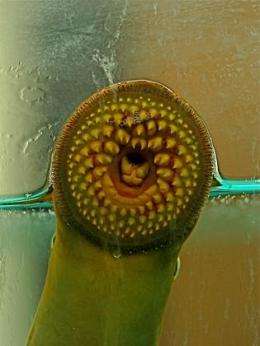Researchers discover genetic clues to evolution of jaws in vertebrates

(PhysOrg.com) -- A half-billion years ago, vertebrates lacked the ability to chew their food. They did not have jaws. Instead, their heads consisted of a flexible, fused basket of cartilage.
This week, an international team of researchers led by a faculty member from the University of Colorado at Boulder published evidence that three genes in jawless vertebrates might have been key to the development of jaws in higher vertebrates.
The finding is potentially significant in that it might help explain how vertebrates shifted from a life of passive "filter feeding" to one of active predation.
"Essentially what we found is that the genetic roots of the vertebrate jaw can be found in the embryos of a weird jawless fish called the sea lamprey," said Daniel Meulemans Medeiros, an assistant professor of ecology and evolutionary biology at CU-Boulder and lead author of the study.
Medeiros' team included Robert Cerny, assistant professor of zoology at Charles University in Prague; Maria Cattell, a researcher in the Medeiros lab; and Tatjana Sauka-Spengler, Marianne Bronner-Fraser and Feiqiao Yu from the California Institute of Technology. Their findings were published in the Sept. 22 edition of the Proceedings of the National Academy of Sciences.
Lampreys are eel-like fish with no jaws and a "very strange skeleton compared to their cousins" with jaws, Medeiros said. But "when we looked carefully at how genes are used during the development of the lamprey head, we saw that the basic plan for a jaw is there, and that only a few genes likely had to be moved around to create full-blown jaws."
Between jawless vertebrates -- called agnathans -- and vertebrates with jaws -- called gnathosomes -- only three genes of the 12 genes the team looked at appeared to be used differently, Medeiros said. This finding suggests that "creating a jaw in a jawless ancestor was a relatively simple matter of altering when and where these few genes are used."
The findings support a new scenario for jaw evolution, an area that has been an open question in vertebrate evolution. Viewing the eel-like fish, "It was hard to imagine how something like that could evolve into the strong, snapping, biting, chewing jaws of a shark, fish or mammal," Medeiros said.
Medeiros' work is supported by a $400,000 grant from the National Science Foundation. The Caltech researchers are supported by a $393,000 grant from the National Institutes of Health. Cerny's research stems from a grant from the Academy of Sciences in the Czech Republic.
Provided by University of Colorado at Boulder












